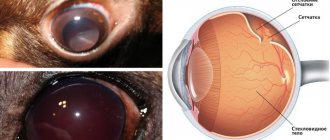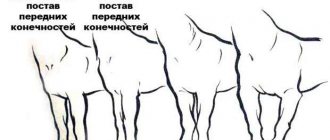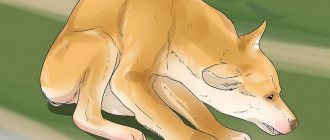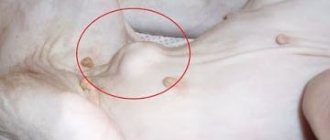Diagnostics
Based on a number of visual manifestations, detailed complaints from the owner and specific tests, a specialist can easily determine ataxia and its form. But in order to find out the root cause of the pathology, it is necessary to donate blood and undergo an MRI - an extremely informative diagnostic option for suspected ataxia. If the clinic does not have such equipment, use an x-ray.
The symptoms of vestibular ataxia are quite striking. In this case, an additional otoscopy (detailed examination of the ear) is performed, and a CT scan or ultrasound is required if there is no way to undergo an MRI.
Ataxia in dogs: symptoms
In Greek, the word ataxia means “without order.” This description speaks volumes about the symptoms of the disease. With progressive ataxia, the dog looks “drunk”: falls, stumbles, turns its head, crouches when turning. At the same time, moving in a straight line is quite easy for sick dogs, but the pet is not able to climb the stairs, walk along a winding corridor, or change the trajectory of movement.
A dog with ataxia has difficulty feeding on his own.
Dogs with ataxia may even bump into large objects, are unable to jump, make a turn, are unable to chase a person or other animal, or play with their relatives. Animals with a damaged cerebellum move with small “goose steps”, and at the same time they can walk too wide, placing their paw much further than necessary.
Some owners confuse the manifestations of ataxia with epilepsy, as animals often shudder, suffer from dizziness, their head shakes, their eyelids and chin tremble. Convulsive jerks and movements usually occur in a situation where the animal is concentrated, for example, eating or trying to plot a route.
Causes of cerebellar ataxia
Ataxia may be a consequence of:
- severe head injury (traumatic brain injury);
- accumulation of fluid in the cavities of the brain, spinal canal (hydrocephalus);
- congenital malformation of the brain/skull;
- infectious disease of the brain (encephalitis);
- cerebrovascular accidents (ischemic stroke);
- cerebral palsy;
- epilepsy in children;
- malignant neoplasms;
- abscesses.
Sensitive ataxia syndrome develops as a result of damage to:
- posterior brain stems,
- peripheral nodes,
- posterior nerves, optic thalamus,
- parietal lobe of the brain.
Cerebellar ataxia is a consequence of damage to the cerebellar vermis, its peduncles and hemispheres. Occurs in encephalitis, sclerosis.
The vestibular form of the disease is caused by damage to any part of the vestibular apparatus - nuclei in the brain stem, cortical center in the temporal lobe of the brain, vestibular nerve, labyrinth.
Cortical ataxia occurs when the frontal lobe of the brain is damaged, which is caused by disturbances in the functioning of the fronto-pontine-cerebellar system.
The best doctors for the treatment of ataxia
8.4 13 reviews
NeurologistHirudotherapistDoctor of the highest category
Zanegin Dmitry Andreevich Experience 14 years 8.4 7 reviews
NeurologistCardiologistGastroenterologistArrhythmologistTherapistDoctor of the highest category
Karmanov Sergey Sergeevich Experience 12 years Candidate of Medical Sciences9 2 reviews
VertebrologistReflexotherapistNeurologistDoctor of the highest category
Sbitneva Natalya Georgievna Experience 39 years 8.6 7 reviews
Neurologist
Bondareva Anastasia Nikolaevna Experience 9 years 8.2 2 reviews
NeurologistDoctor of the first category
Kubyshta Svetlana Mikhailovna Experience 14 years 8.7
NeurologistNeurophysiologistFunctional diagnostics doctor First category doctor
Seleznev Fedor Alekseevich Experience 9 years Candidate of Medical Sciences8.8 41 reviews
NeurologistManual therapist
Podryadov Nikolay Evgenievich Experience 34 years 8.8 124 reviews
Neurologist
Gadaborsheva Tamara Magomedovna Experience 41 years 9.5 76 reviews
ReflexologistNeurologistManual therapistDoctor of the highest category
Shnigirist Alexander Ilyich Experience 27 years Candidate of Medical Sciences8.8 14 reviews
Neurologist Chiropractor Hirudotherapist Reflexotherapist Doctor of the first category
Derzhavina Irina Nikolaevna Experience 35 years
Most often, the main cause of the development of acute cerebellar ataxia is ischemic stroke, which is caused by atherosclerotic occlusion or embolism of the cerebral arteries that supply the cerebellum. A hemorrhagic stroke, compression of the cerebellum under the influence of an intracerebral hematoma or traumatic damage to the cerebellum resulting from a head injury cannot be excluded.
Late cerebellar ataxia of the subacute form often occurs as a symptom of an intracerebral tumor, which is located in the cerebellum. These are astrocytoma, hemangioblastoma, medulloblastoma, ependymoma. It can also develop as a result of normal pressure hydrocephalus arising from subarachnoid hemorrhage.
One of the reasons is meningitis and brain surgery. In addition, this form of ataxia can occur with a lack of vitamins, an overdose of anticonvulsants, an endocrine disorder, for example, with hyperparathyroidism or hypothyroidism. It may be a paraneoplastic syndrome for malignant tumors that are localized outside the brain. This could be lung cancer, ovarian cancer, non-Hodgkin's lymphoma and some other forms of oncology.
Causes
In addition to the hereditary factor, the disease may have other underlying causes.
For cerebellar ataxia:
- neoplasms or cysts in the cerebellum;
- intoxication;
- autoimmune diseases.
For vestibular ataxia:
- otitis media of an infectious or fungal nature;
- neoplasms of the middle ear;
- injuries in the temporal region;
- hypokalemia;
- stroke. For sensitive ataxia:
For sensitive ataxia:
- tumors;
- injuries;
- pathologies of spinal development;
- acute vascular and compression disorders;
- infections.
If a tumor is detected, further treatment includes, first of all, surgery.
For an infectious disease, antibiotics and anti-inflammatory drugs are prescribed.
Intoxication occurs not only due to poisoning by certain poisons, but also due to infection of the dog with worms that release toxins into the animal’s blood. In this case, treatment is carried out with anthelmintic drugs. Folk remedies will no longer help in such serious cases.
For cerebral lesions, nootropics, vasodilators, B vitamins, and nicotinic acid are prescribed to improve cerebral circulation.
Ataxia may result from an autoimmune disease. A healthy immune system identifies and destroys pathogens. But if there is a malfunction in the mechanism of its action, the tissues of the body’s own, including nerves, become the target of immune cells. Then a lack of coordination of movements develops.
If ataxia occurs as a result of trauma, the brain or spinal cord, spine, or nerve impulse pathways may be affected. One of the types of disorder occurs - cerebellar, vestibular or sensitive type. Appropriate treatment is carried out after examination, establishing the cause and making an accurate diagnosis.
Diagnostics
In order to make an accurate diagnosis, a comprehensive diagnosis is carried out. It includes a number of important events.
History taking
The first thing the veterinarian does is collect an anamnesis. Due to this, he is able to exclude other possible diseases and find out the true clinical picture. Only after completing these steps do they resort to laboratory research.
MRI
Magnetic resonance imaging allows you to determine which area of the brain is damaged. With the help of this study, it is possible to assess the condition of the animal and select tactics for further therapy.
Examination and diagnosis
Despite the characteristic signs of the disease, an accurate diagnosis can only be made in a veterinary clinic. As a rule, there is only one examination method - the animal undergoes magnetic resonance imaging. This procedure is performed under general anesthesia and allows the doctor to make a conclusion about the functioning of all parts of the brain, including the cerebellum.
During the diagnosis, the veterinarian must also exclude or detect other or concomitant diseases that may give similar symptoms or be the root cause of ataxia in the animal.
The mechanism of the influence of ataxia on the cerebellum
The cerebellum, or “little brain,” is located at the back of the brain. It is divided into several layers. The inner layer of the cerebellum consists of nerve fibers responsible for the “delivery” of information and forming white matter. The operating principle of this layer can be compared to a telephone line that sends and receives signals. The outer layer is called the cellular layer. Its direct function is to process and make decisions based on the information received. The cells that are located between the two layers of the cerebellum play an important role - they are responsible for developing the most productive movement pattern. Without these cells, the cerebellum becomes useless due to the fact that information simply does not flow to the necessary centers. The ability to maintain balance also depends on the cerebellum, since it is where information from the inner ear goes. The principle of this work is that the fluid contained in the eardrums tends to move in the channels while the animal rotates its head. The movement of this fluid is used by the body as a special transmitter of information. In addition to liquid, the membranes also contain small particles that put pressure on the sensors and allow the animal to assess the situation. The cerebellum also works closely with the vestibular apparatus. Ataxia affects precisely this ability of cells to communicate the necessary trajectory of movements to the dog.
There is a certain classification of the various manifestations of the disease.
- Cerebellar ataxia, which occurs when the cerebellum, specifically the vermis, legs and hemispheres, is affected;
- Sensitive ataxia, observed after damage to the posterior columns or peripheral nerves, thalamus optic, dorsal roots, parietal lobe cortex;
- Vestibular ataxia, which occurs after damage to any part of the vestibular apparatus;
- Frontal ataxia, which manifests itself after damage to the frontal lobes of the brain;
- Psychogenic ataxia, expressed in walking disorders in dogs, which are not typical for organic damage to the nervous system.
Types of ataxia in dogs
The diagnostic process is slightly forgiven only by the presence of several types of ataxia, each of which indicates a specific localization of the pathological process:
- Vestibular form. As the name suggests, in this case the vestibular apparatus is affected, which allows the animal to maintain balance. In severe forms of vestibular ataxia, the dog is not even able to sit. In addition, this form is characterized by whirling in one place, constant and “versatile” movements of the eyeballs. In severe cases, a lethargic state also develops, the pet may be numb, and complete or partial paralysis is possible.
- Sensitive form of ataxia. It is considered the most severe option, since in this case the spinal cord is affected, as well as the Gaulle and Burdach bundles. With this form, the animal can usually walk, but while moving, the dog will constantly and carefully look at its feet. Possible deterioration of reflexes associated with the spinal cord. In severe cases of sensitive ataxia, the pet quickly breaks down into complete paralysis.
- Cerebellar ataxia. It is easy to understand that the cerebellum is affected. The main difference between this form of ataxia and others is the change in behavioral aspects. Simply put, the dog begins to behave strangely and uncharacteristically, which can even be expressed in unmotivated aggression. This is exactly the form of ataxia that develops with rabies!
However, cerebellar ataxia should be discussed in more detail. In addition to all of the above, this type of pathology leads to severe impairments in coordination of movements and the ability to navigate in space.
In severe cases, the dog may not even understand where it is and may not recognize its owner. This, by the way, is what can cause aggression: when a dog panics, it is confused and scared. If at this moment a “stranger” person approaches her (whom she simply does not recognize), the outburst of aggression may be an unconscious attempt to defend herself.
Ataxia in puppies
Although most cases of congenital ataxia develop in dogs during adulthood, abnormalities that are noticeable from birth occasionally occur. Problems with the musculoskeletal system and coordination problems are clearly expressed.
The puppies try to move their paws, but cannot walk. There is a shaking of the head and twitching of the eyes. Otherwise, babies develop normally - they are active, inquisitive, and have a good appetite. But such dogs will never be able to move.
To avoid acquiring a carrier or a sick puppy, you must first take into account the breed’s genetic predisposition to ataxia. Secondly, it is better to purchase a small pet from a trusted nursery with a good reputation. A responsible breeder will not allow a sick dog to breed, and if there is concern, he will conduct a DNA test on individuals intended for mating.
Ataxia in dogs is a disease that gives the animal virtually no chance if the owner does not notice alarming symptoms in time and does not seek help from a veterinarian. The disease is associated with dysfunction of the cerebellum, the main part of the brain. With severe ataxia, the dog loses the ability to coordinate its movements and maintain balance. This disease can be congenital, genetic, or acquired. Today we will talk about the causes of ataxia in dogs, its symptoms and treatment.
Ataxia in dogs: symptoms and treatment
Dogs that, for some reason, have developed ataxia, that is, the cerebellum functions with disturbances or does not perform its function at all, lose the ability to move in space. You need to understand that the muscle strength and performance of the limbs do not disappear, but the animal simply cannot use its paws.
Disturbances in the functioning of the cerebellum are characterized by such unpleasant consequences as impaired coordination and balance; therefore, the dog seems to be “dangling” in space, unable to control its own body. Accordingly, pets with ataxia continue to exist, can eat and drink and even move around, but only with the help of the owner.
Types of ataxia in dogs
In addition to the cerebellar, there are other types of ataxic lesions of the dog’s brain:
- frontal lobes;
- channels responsible for vision;
- crown areas;
- posterior nerve canals;
- mental;
Table. Variations of ataxia in dogs
The types of ataxia differ only in the location of damage to the nervous system; they do not differ in symptoms or treatment methods.
Causes of other types of ataxia
They may be different. As you remember, vestibular and sensory ataxia develop against the background of damage to the vestibular apparatus, or nerve cords. The first reason that comes to mind in these cases is oncology. If the tumor damages these important organs, many unpleasant symptoms will develop, which we have already discussed above.
Sometimes toxins can be the cause. Moreover, we are talking not only about poisons, but also about those substances that helminths release into the general bloodstream (especially in a puppy). If your dog has a multi-meter cucumber tapeworm in his intestines, then in some cases it can even lead to encephalopathy, not to mention motor dysfunction. Fortunately, if the guests are destroyed in time, the pathological process will not have time to go far (most likely).
But still, poisoning is more common. If your pet picks up a poisoned bait containing, say, strychnine while on a walk, then it may well show symptoms of ataxia. Of course, if you don’t provide him with help within a couple of hours maximum, then this is the least of all problems.
Autoimmune diseases are very insidious. For example, systemic lupus. At the same time, the body begins to destroy itself, and the nervous system may well come under attack. Signs of ataxia in such conditions are common. The prognosis is bad.
Finally, injuries. A dog that has fallen under the wheels of a bicycle or car is unlikely to glow with health. Ataxia in this case is very likely, and its causes can be very serious: up to a hematoma in the dura mater, pinched nerve cords or a “banal” traumatic brain injury. If your dog starts behaving strangely after something bad happened to him, take him to the vet immediately!
In all the cases we describe, treatment depends on the cause. In simple cases (helminths), everything is solved by simply eliminating the predisposing factors, after which the animal returns to normal. If ataxia occurs against the background of a serious injury, only emergency surgery, etc., can save the animal.
Methods for diagnosing cerebellar disorders
Neuroimaging methods (CT, MRI) are used to diagnose cerebellar disorders. In case of inflammatory changes, it is important to study blood and cerebrospinal fluid (search for antibodies to viruses).
But objective neurological research techniques make it possible to identify abnormalities characteristic of this particular part of the brain. The neurologist conducts tests during an objective examination. A neurological hammer is required as a special device.
The following samples are used:
- Finger;
- Index finger;
- Romberg test;
- Babinsky;
- Knee-heel;
- For dysmetria;
- For diadochokinesis;
- For nystagmus;
- For gait disorders.
Finger test
The patient is in a sitting or standing position. The doctor asks him to straighten his arm and move it to the side. Then the patient should touch the tip of his nose with his index finger. In this case, you need to perform the test with your eyes open and closed.
A patient with organ damage misses his finger on the affected side. At the same time, he has intention tremor of the hand and index finger. For problems with the cerebellum (ataxia), open or closed eyes do not affect the quality of diagnosis.
Finger pointing test
There are several modifications of the test. Most often, the patient is asked to spread his arms to the sides and bring them together, touching each other with his index fingers. A test is possible when the doctor puts his finger or a rubber band of a hammer.
On the affected side, the patient misses the target. In this case, a tremor appears in the hand. The finger deviates outward from its normal position. Performing with eyes open or closed does not affect the outcome.
Romberg test
Static ataxia is examined in this position. The patient stands straight, arms are lowered along the body, feet are brought together. The doctor stands behind, if necessary, insures the patient. If there is no wobble, then the test becomes more complicated.
The patient stretches his arms forward and tries to stand. If no problems are found, but the patient places his feet in one line. When performing the test, the patient falls in the direction of the lesion. However, open or closed eyes do not affect stability.
Babinski test
In the supine position, the patient crosses his arms. Then he needs to sit down without changing their position. When standing up, the patient's legs also rise. In this case, the leg on the affected side will rise higher.
The second asynergy test is also performed while lying down. The doctor bends the patient's arm at the elbow and places it on his chest. Now he must straighten his arm and suddenly let go. A patient without brain damage will restrain his hand and prevent the blow. After all, his antagonist muscles work. The patient will hit himself with his fist.
Knee-heel test
The patient is sitting. The doctor says to touch the opposite knee joint with your heel. Then go down the lower leg to the ankle. On the affected side, the patient with problems misses the knee. The heel jumps off the shin due to its greater amplitude. Opening or closing your eyes does not affect the sensitivity of the test.
Dysmetria test
Dysmetria is impaired proportionality of movements. In this case, the patient is asked to extend his hands, palms up. Next, he closes his eyes and turns them palms down. Excessive pronation is observed on the affected side. The palms rotate differently.
For diadochokinesis
Adiadochokinesis is the inability to quickly perform opposite movements. The patient is asked to perform supination and pronation in the wrist joint. In this case, on the affected side, the hand lags behind and makes excessive inaccurate movements. In this case, rapid depletion is observed.
For nystagmus
The doctor asks the patient to look at the hammer. He moves it up, down, to the sides. The patient watches him without turning his head. At the same time, rapid repeated movements of the eyeballs begin on the affected side.
Gait disorders
The patient is asked to walk forward and backward in one line. In this case, the test is first performed with open and then with closed eyes.
A patient with organ damage deviates to the side. In addition, his gait is characterized by long steps. He walks like he's drunk. Spreads legs wide apart. The body tilts in the direction where the cerebellar lobe is affected.
Diagnostics and therapeutic techniques
If you suspect your pet is suffering from cerebellar ataxia, contact your veterinarian immediately. The fact is that today there is not a single specific analysis or diagnostic method that would make it possible to unambiguously identify cerebellar ataxia (or another type) in a dog. The diagnosis is made based on the combination of the clinical picture, a complete examination and a whole range of tests.
Blood and urine tests are required. MRI is very useful, but not every city has the opportunity to do it. So sometimes they limit themselves to simple radiography. Other tests may be ordered depending on what your veterinarian finds during initial testing.
Treatment for ataxia in dogs will depend on the cause. If an infection or tumor is found, powerful broad-spectrum antibiotics are administered or surgery is used accordingly. However, there is no cure for ataxia caused by a congenital or hereditary defect. In these cases, supportive treatment is the only way out, and it is aimed at maintaining the animal’s normal standard of living.
As a rule, with such therapy, sedatives and sedatives are prescribed. They relieve the animal's panic state. To treat movement disorders, more specific medications are used, which should only be prescribed by a veterinarian. Under no circumstances “stuff” the animal with them yourself, as you can only make things worse.
Animals suffering from cerebellar ataxia must be kept at home. In the room where the dog will be most of the time, there should be no sharp corners, foreign objects or furniture, as the pet’s condition will inevitably (alas) worsen. In this case, the dog will inevitably start to bump into furniture and corners, which can lead to an even worsening of the process, and you shouldn’t forget about the likelihood of “simple” injuries.
Some pets with congenital or hereditary ataxia live with this pathology all their lives, and it does not particularly bother them (the body adapts to this condition to some extent). Alas, in other cases the constant progression of the disease can cause euthanasia, since it is difficult for a dog to live in a vegetable state. If the dog cannot even stand up, or falls every step, there is nothing immoral in euthanasia.
Diagnosis and treatment
There are no specific tests or diagnostic methods to detect ataxia. The diagnosis is made after a series of examinations and the exclusion of other, less serious diseases with similar symptoms. The most informative will be a magnetic resonance or computed tomography scan. In the absence of the necessary equipment, they are limited to radiography.
In the case of hereditary ataxia, a DNA test is performed for diagnostic purposes. A complete genetic treatment for a disease of this nature has not been developed. Over time, a sick dog becomes practically incapacitated. The veterinarian prescribes maintenance therapy to alleviate the condition and maintain normal living conditions for the pet. Most often this is symptomatic therapy in the form of sedatives, sedatives and vitamins.
It is important to create the most comfortable living conditions for a sick dog, because it will no longer be able to cope without the participation and care of its owner. It is better to provide your pet with a separate room without traumatic objects, sharp corners and interior items.
If the disease arose for another reason, then treatment of ataxia in dogs is aimed primarily at eliminating it.
The animal body is able to partially compensate for existing disorders. When one part of the brain is damaged, another area of the brain takes over a share of its functions. In addition, dogs are taught to control the strength, speed and range of movements using their visual abilities. In this regard, manifestations of the disorder are noticeable only when the animal is tired or excited.
These body abilities can not only prolong the dog’s life, but also make it close to normal, despite the disorder.
What causes vestibular ataxia in dogs?
As mentioned earlier, the main reason for the development of the disease is heredity, that is, the disease develops when a dog suffering from this disease participated in their mating. Once we have figured out what it is, it is worth discussing other reasons that can trigger the appearance of the disease in a dog. Here are the main ones:
- tumors;
- serious infectious diseases;
- otitis;
- neuritis;
- serious injuries resulting in damage to the animal’s brain.
Symptoms of the disease
When the symptoms of a disease in dogs are mentioned, this is exactly what should be discussed first, because they can identify the disease in the early stages. Let's look at the symptoms that occur most often, here is a list of them:
- constant trembling, as well as noticeable nervousness;
- lack of coordination of movements, which may give the impression that the dog is drunk;
- strange walking, the essence of which is steps of different lengths and constant stops;
- constant falls that occurred, it would seem, on a straight road;
- severe panic in the dog, which is most often expressed in panic attacks;
- the animal’s desire to quickly hide somewhere and not move;
- weakness that becomes more pronounced over time;
- random rotation of the head or, for example, eyeballs;
- lethargy;
- decreased appetite (the amount of food eaten decreases);
- hearing impairment;
- changes in behavior, decreased activity;
- constant head tilt, which was not previously characteristic of a particular dog.
It is not necessary that all the symptoms on this list will appear immediately, since the disease manifests itself in different ways. But if there are at least a few signs, it’s worth showing the animal to a specialist, because even if your fears are not confirmed, the dog will still have some problems. You can find out about them from your veterinarian.
Treatment of ataxia in an animal
It’s worth mentioning right away that most people, having heard that their pet has suffered such a terrible diagnosis, are interested in the possibility of treatment. The fact is that the treatment of the disease is of great interest to pet owners; it is considered an incurable disease. We are talking about ataxia that appeared due to a hereditary factor or some defect. The fact is that no special drugs have been invented that would have a qualitative effect on the animal’s cerebellum.
But if a tumor or, for example, some kind of infectious disease was discovered in the dog (in cases where this became the cause of the development of the disease), then you can try to cure it. Fortunately, modern antibiotics, developed specifically for dogs, help fight many terrible diseases that in the recent past caused the death of pets. Surgery can also help (for tumors), but the cerebellum cannot be affected in any way. You ask: “What can be done if ataxia was caused precisely by a hereditary factor?” In fact, all you have to do is come to terms with the problem and purchase medications that will help make the dog’s future life calmer and more enjoyable.
Most often, special sedatives are prescribed for this purpose, which help relieve panic. There are, of course, special medications for movement disorders, but often they can only make things worse for the dog. Consult a veterinarian, because if the wrong medications are chosen, the animal may die.
Further life of dogs: basic rules
Your task is to improve the dog's future life. Under no circumstances should she live on the street, even if she has an excellent kennel. The fact is that a dog whose coordination is impaired can harm itself without proper supervision. In the room you allocate for your dog, there should be no objects that have sharp corners, because, despite all the prescribed medications, the pet’s condition will suffer changes, and for the worse. If, when visiting the veterinarian, the dog simply sometimes stopped or stumbled, then after a few years he will most likely constantly bump into pieces of furniture or even crash into walls. The dog will get injured, and you should at least reduce the number of injuries to a minimum.
It is also worth noting that some animals may, over time, begin to adapt to life with a congenital pathology, but this process is not typical for all breeds. In some cases, the dog will even move more or less independently, avoiding small obstacles. But there are also not so good situations; sometimes you have to put the dog to sleep so that it simply stops suffering. This happens only on the initiative of the owner (when the dog loses interest in life and the ability to move independently, when it just sleeps and eats). You should not think that euthanasia is an immoral process and that people who do not love their pet resort to it.
Video about ataxia in dogs
Ataxia in dogs is a complex, fatal disease. It is characterized by impaired functionality of a special part of the brain, the cerebellum. The cerebellum is responsible for coordination of movements and balance. Therefore, any deviations from the norm lead to dire consequences.
The cerebellum, due to its structure, is a kind of nerve center between the desire to move and the ability to carry out movement. In fact, the nerve cells of this part of the brain transmit information about the need to make any movement.
Possible reasons for the development of the disease are as follows:
- Hereditary problems.
- Existing tumors.
- Brain damage.
- Complications of infectious diseases.
Ataxia has a long history; doctors have even been able to determine which breeds are most susceptible to the disease: Scotch terriers, Staffies, cocker spaniels, some breeds of shepherd dogs, Chinese Cresteds. Depending on the location of ataxia, the following types of disease are distinguished:
- Cerebellar.
- Sensitive: damage to the posterior nerve canals, visual, parietal areas.
- Vestibular.
- Frontal ataxia.
- Mental: atypical damage to the nervous system.
Regardless of location, the symptoms of ataxia are not very diverse. Coordination is the first to suffer. It is difficult for the dog to move, especially to make complex movements: turning, bending, jumping. Movements strictly in a straight line are usually easy, sharp turns cause loss of coordination, the animal crouches, unable to move further.
The second common symptom is eye tremor, twitching of the eyelids. This happens due to dizziness, the dog loses contact with the surrounding space and falls. Nervous, convulsive twitching resembles epileptic seizures.
Trembling becomes a specific sign, especially in moments of strong tension, when the dog is trying to focus on a certain point or eat something. Diagnosis is usually made using magnetic resonance imaging
The image will show abnormal development of the cerebellum, abnormal functioning.
Types of disease
Regardless of the type of disorder, the symptoms of ataxia are manifested by an awkward gait, the inability to overcome an obstacle or climb stairs, trembling, and increased tone of the paws. The gait becomes similar to a rooster's step - with the forelimbs raised high. There is a constant tilt to one side, dizziness due to sudden and frequent shaking of the head. Nystagmus is periodically observed - a short pendulum movement of the eyes from side to side.
As the disease progresses, the animal loses weight due to difficulty feeding.
In clinical practice, there are three types of ataxia:
- cerebellar;
- sensitive;
- vestibular.
The cerebellum is a part of the brain that is responsible for the position of the body in space, coordination of movements and balance in various external conditions. With cerebellar ataxia in dogs, there are no structural changes in this organ. Its biochemical composition changes due to the loss of some Purkinje cells. These cells are a kind of dispatchers, transmitters of information into the cerebellum, to or from the white matter, to the outer layer.
Cerebellar ataxia in dogs has two types – static and dynamic. In the first case, it is difficult for the animal to stay in a motionless position. The dog has difficulty standing on widely spaced paws. Trying to maintain balance, he may fall on his side or forward. With dynamic cerebellar ataxia, discoordination manifests itself during movement, especially when turning.
Sensitive ataxia is less common. It can be differentiated from other types by increased symptoms when closing the eyes. In this case, the dog’s perception of its body in space – proprioception – is disrupted.
Depending on the area of damage to the nerve impulse pathways, only the pelvic limbs or all four legs may be affected.
Vestibular ataxia occurs when the labyrinth, which perceives changes in the head and body in space, as well as the direction of movement, is damaged. The dog seems to be on an inclined surface. The animal tries in vain to maintain balance. With this type of disorder, the dog's body is tilted to one side, movements are slow and cautious. Deterioration and loss of hearing, drowsiness, and numbness are observed. The pet moves in circles, which causes dizziness and vomiting.
Treatment of ataxia
If the owner’s desire to save the dog by any means overpowers the humane solution, then veterinary specialists will recommend using painkillers that relieve nervous tension. Of course, treatment is especially effective if a non-genetic cause of the disease is established. Anti-inflammatory, antispasmodic drugs, B vitamins are prescribed
It is important to try to provide the dog with comfortable conditions that take into account lifelong characteristics. Brain damage is rarely completely cured
From the moment the diagnosis is made and the first symptoms appear, a disabled dog becomes completely dependent on people. Sensitive, attentive attitude will extend the life of your beloved pet for many years.
Ataxia in dogs is considered one of the most terrible diseases based on the genetic principle of distribution. It always appears as a result of damage to the cerebellum, and this disease is characterized by problems that make the dog’s movements unusual, or rather, abrupt and disproportionate.
Dogs affected by this disease often begin to fall, and they also lose their balance. It is worth noting that the strength in a dog’s limbs with such a disease does not disappear anywhere, but the effect cannot be achieved, because the dog completely loses the skill associated with moving in space. Yes, such dogs can still eat and continue to live, but only with constant human care and attention.
What do you prefer to feed your pets?
Poll Options are limited because JavaScript is disabled in your browser.
- Porridge with various additives 46%, 7427 votes
Dry food only 26%, 4165 votes
Ataxia in dogs is a disease that gives the animal virtually no chance if the owner does not notice alarming symptoms in time and does not seek help from a veterinarian. The disease is associated with dysfunction of the cerebellum, the main part of the brain. With severe ataxia, the dog loses the ability to coordinate its movements and maintain balance. This disease can be congenital, genetic, or acquired. Today we will talk about the causes of ataxia in dogs, its symptoms and treatment.
Ataxia in dogs: symptoms and treatment
Dogs that, for some reason, have developed ataxia, that is, the cerebellum functions with disturbances or does not perform its function at all, lose the ability to move in space. You need to understand that the muscle strength and performance of the limbs do not disappear, but the animal simply cannot use its paws.
Disturbances in the functioning of the cerebellum are characterized by such unpleasant consequences as impaired coordination and balance; therefore, the dog seems to be “dangling” in space, unable to control its own body. Accordingly, pets with ataxia continue to exist, can eat and drink and even move around, but only with the help of the owner.
Types of ataxia in dogs
In addition to the cerebellar, there are other types of ataxic lesions of the dog’s brain:
- frontal lobes;
- channels responsible for vision;
- crown areas;
- posterior nerve canals;
- mental;
Table. Variations of ataxia in dogs
The types of ataxia differ only in the location of damage to the nervous system; they do not differ in symptoms or treatment methods.
Prognosis and prevention
The prognosis for the patient depends solely on the cause that triggered the onset of the disease. Acute and subacute ataxia caused by intoxication of the body, vascular disorders, and inflammatory processes can completely regress or partially persist. In this case, the prognosis for the patient will be as favorable as possible if the provoking factor can be eliminated in time: infection, toxic effects, vascular occlusion.
The chronic form of ataxia is characterized by a gradual increase in symptoms, which ultimately leads to disability of the patient. The greatest danger to the patient's life is cerebellar ataxia caused by tumor processes. The rapid development of the disease and disruption of the functioning of many organs leads to serious complications that significantly worsen the patient’s quality of life.
Prevention of cerebellar ataxia involves preventing traumatic brain injury, infection of the body, the development of vascular disorders, timely treatment of chronic cerebral ischemia, compensation for metabolic and endocrine disorders, and mandatory genetic counseling during pregnancy planning.
Symptoms
Symptoms of cerebellar ataxia progress over several years or months (which is less common). As a rule, up to two years the clinical picture does not develop at all. The most common symptoms of ataxia in dogs are:
Trembling, nervousness, the pet may be inadequate.
When walking, she behaves extremely strangely and unusually. For example, he takes incredibly long steps, freezing after each of them for a second and a half.
Loss of coordination (first symptoms).
Panic attacks. The animal is confused, excited, trying to hide somewhere.
From time to time the dog falls while walking.
Progressive weakness.
Sometimes the dog begins to quickly rotate its head, and erratic, circular movements of the eyeballs are also observed.
The clinical picture also includes:
Constant head tilt.
Hearing impairment.
Lethargy.
A sharp decrease in appetite.
Other changes in behavior.
Diagnostics
If one or another symptom of this disease becomes noticeable in a dog, there is a need for an MRI. The resulting images show cerebellar atrophy of varying severity. A DNA test for the NCL-A gene, which is responsible for the development of cerebellar ataxia, is also available.
To carry out the test, material is taken from the inside of the cheek (buccal scraping). After a few days, results are received that make it possible to exclude other possible neurological diseases with similar symptoms and make an accurate diagnosis even at an early stage of the disease. These results are extremely important, since with their help it is possible to stop the further spread of the hereditary defect in the breed by eliminating carriers of this gene from breeding.
How it arises and is transmitted
Ataxia in dogs can be inherited, and only if both parents of the puppy are either carriers of the damaged gene or are already sick. The disorder can also occur due to a number of diseases that damage:
- cerebellum;
- vestibular apparatus;
- a system of nerve fibers that conduct impulses from the brain or spinal cord to the motor organ.
The following dog breeds are more susceptible to ataxia than others:
- bobtail;
- Scottish Terrier;
- amstaff;
- Scottish Setter;
- Cocker Spaniel;
- Mountain Dog;
- Australian Kelpie;
- Border Collie.
Breeders who breed these breeds perform a genetic test on their pets to identify carriers of the gene even before clinical signs of the disease appear. Such dogs are excluded from breeding, which avoids the spread of the defect.
Symptoms
The first symptoms appear at the age of 3-5 years, but in some cases the disease may appear at an earlier or later age. Owners note an occasional lack of coordination; the dog loses its balance and stops jumping over obstacles that were previously not difficult to overcome. Over time, the disease progresses. The animal experiences difficulties when climbing upward, falls when turning or making sudden movements (usually at the beginning of movement), gait is disturbed - movements become abrupt, with increased amplitude (hypermetry). Tremors (large shaking) are common. With this pathology, a pendulum-like movement of the eyes often appears - nystagmus, which becomes especially noticeable if the dog is turned over on its back or after shaking itself and other sudden movements of the head.
Read with this
- Pyoderma in dogs: causes, symptoms and treatment
- What to do if your cat won't eat: possible causes and primary care
- The cat drinks a lot of water
- What to do if the cat is poisoned: instructions
- How to treat a cat with a cold at home
- Stomach disease in cats symptoms
- Allergies in dogs
- The hamster is chewing twigs in the cage: what to do?
- Why doesn’t the dog eat or drink anything and what should be done?
- Lameness in dogs










